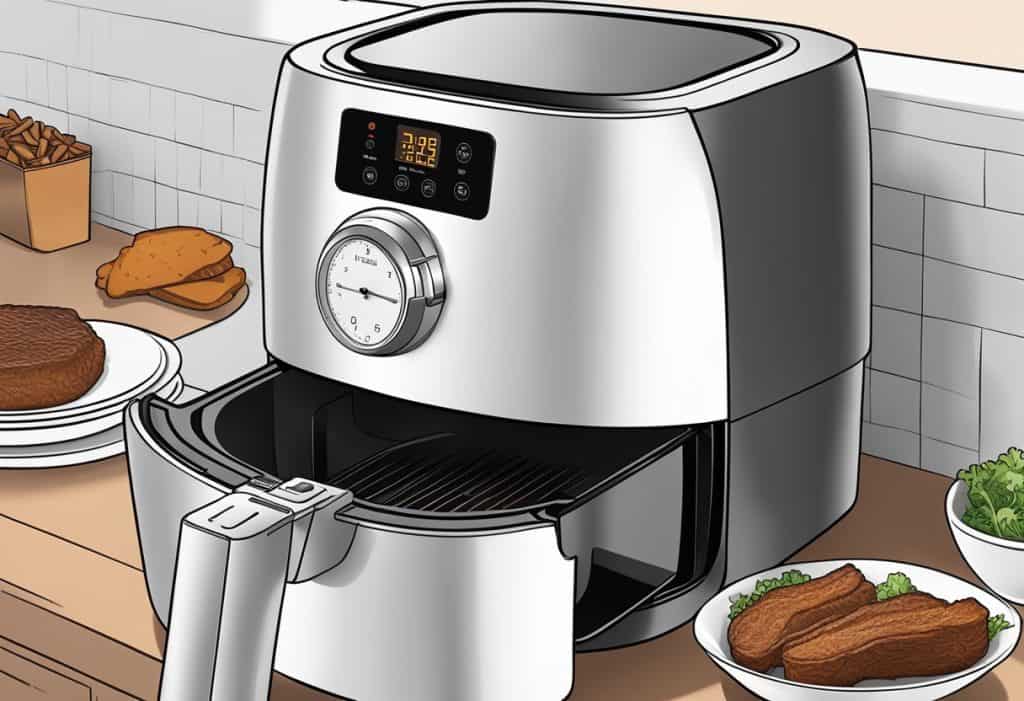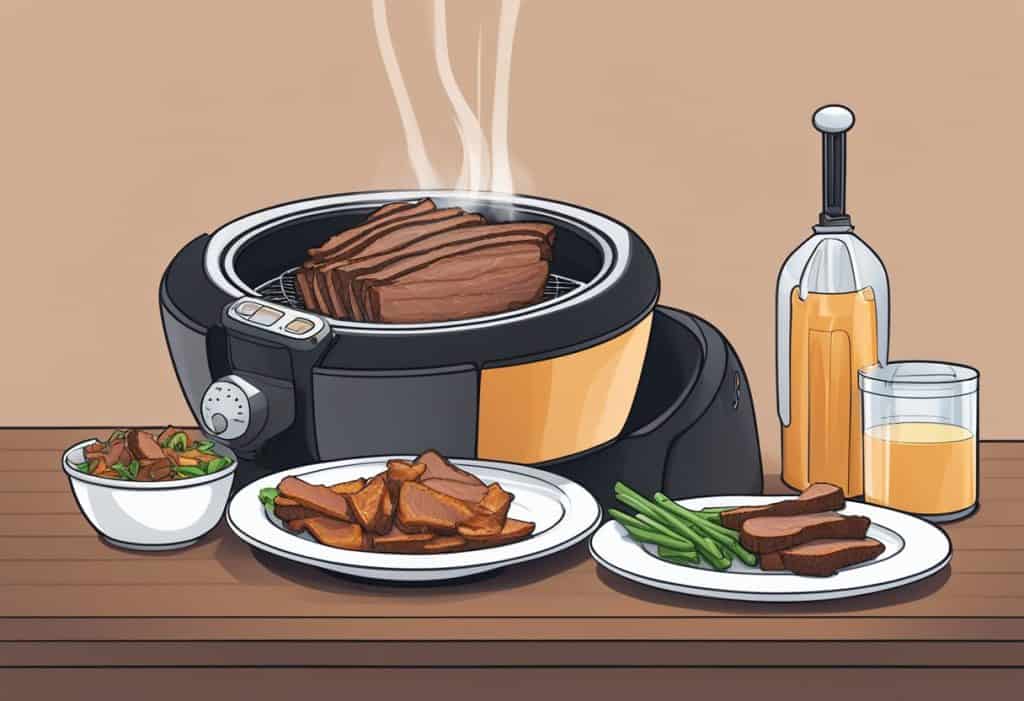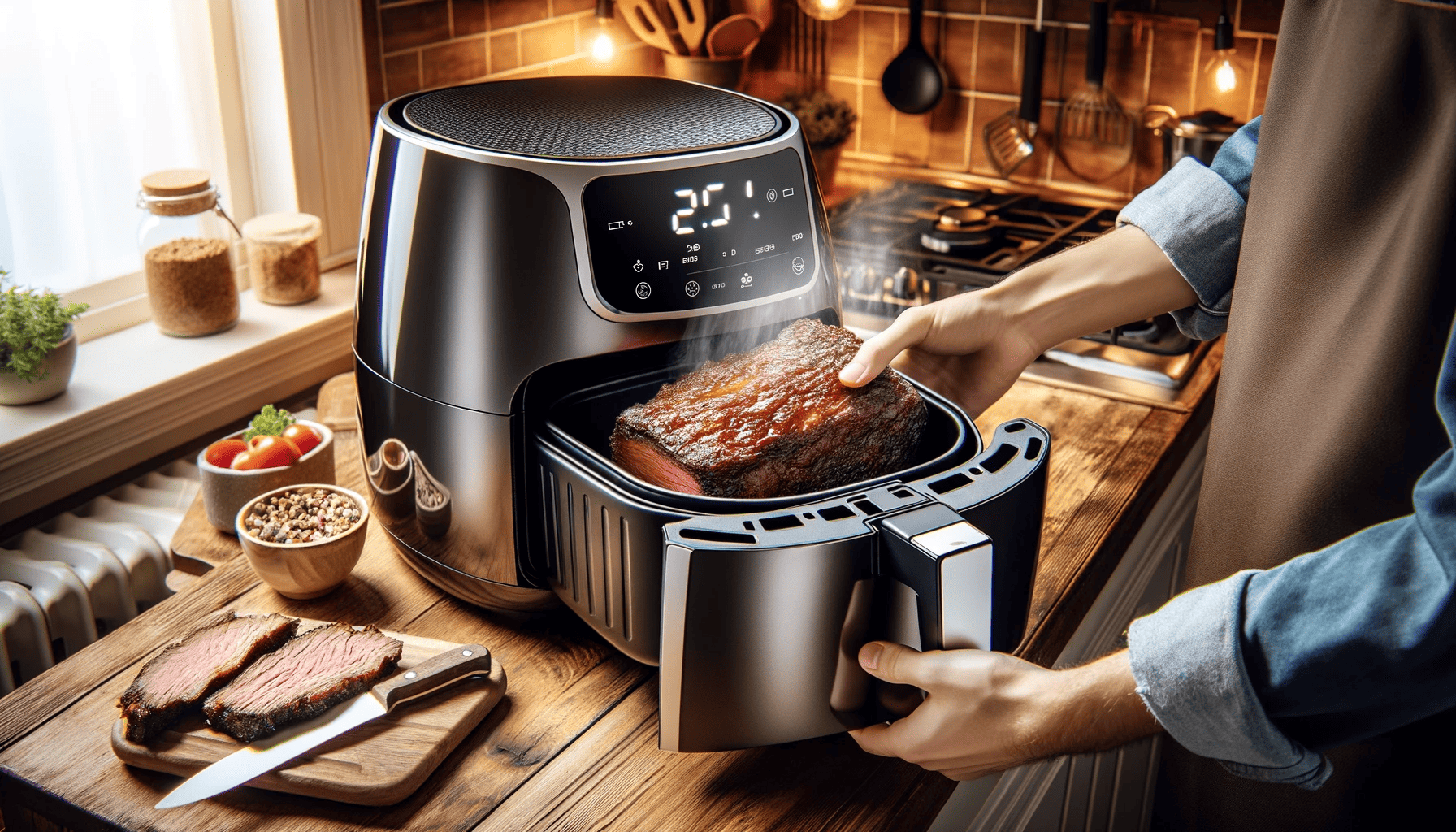If you’re looking to revive your leftover brisket while keeping it juicy and tender, an air fryer is your go-to kitchen hero. In this guide, we’ll explore the ins and outs of using an air fryer to bring your brisket back to life just as delicious as when it first came off the grill.
Essentials of Reheating Brisket
Reheating your leftover brisket in an air fryer can keep it moist and tender if you follow the right steps and maintain the best practices to preserve its flavor.

Reheating Brisket in the Air Fryer
To reheat brisket in an air fryer, preheat the device to a low temperature setting—ideally around 250°F (120°C) to ensure tender and juicy meat without drying it out. Place slices of brisket in a single layer to avoid overcrowding; this promotes consistent cooking temperatures.
Wrap the brisket in aluminum foil to retain moisture; the foil acts as a barrier, keeping the brisket flavorful and preventing direct exposure to the air fryer’s intense heat.
Aim for a cooking time of about 15-25 minutes, depending on the thickness of the slices, and use a meat thermometer to ensure the brisket reaches an internal temperature of 165°F (74°C)—the safe reheating temperature.
- Air Fryer Settings:
- Temperature: 250°F (120°C)
- Time: 15-25 minutes (adjust based on thickness)
- Endpoint: Internal temperature of 165°F (74°C)
Avoiding Common Pitfalls
The key to avoiding a dry and unappealing brisket when reheating is to not rush the process. High heat can compromise the brisket’s tenderness, so stick with the low temperature.
Also, make sure not to cram too much meat at once; crowding can cause uneven reheating and issues with moisture retention.
It’s better to reheat in batches than to risk an inferior outcome. Remember, an air fryer works by circulating hot air, and when the meat is crowded, it obstructs this airflow.
In comparison, using an oven may offer more space but often doesn’t provide the same consistent heat as the air fryer. So, when using your air fryer, monitor your meat and consider turning it halfway t ough cooking to ensure even reheating.
Optimizing Flavor and Texture
When reheating brisket in your air fryer, the goal is to maintain that juicy tenderness while reviving the smoky flavor and a crispy exterior. The crux here is to handle your sliced brisket with care, using just the right techniques so that it comes out as delicious as when it was first cooked.

Achieving the Right Slicing Techniques
Before popping your brisket into the air fryer, consider the size and thickness of your slices. You want to aim for thinly sliced brisket; thin slices heat more evenly and quickly, capturing the essence of the meat without drying it out. Thick slices can take longer to warm up, increasing the risk of a dry and tough texture.
- Slice Against the Grain: Find the direction of the muscle fibers and slice perpendicular to them. This makes the brisket more tender.
- Keep Slices Uniform: Uniformity in thickness ensures each piece warms at the same rate, retaining juiciness.
- Pre-slicing: Slice your brisket before reheating. This allows you to coat each slice evenly with cooking juices or BBQ sauce, enhancing flavor and aiding in moisture retention.
When adding your sliced brisket to the air fryer, lay the pieces out in a single layer to allow for even air circulation. If the slices overlap, they may steam rather than crisp, denying you that sought-after crispy exterior.
Remember, while adding cooking juices or a brushing of BBQ sauce can introduce additional moisture and flavor, be judicious to avoid sogginess. A light coating will contribute to both the smoky flavor and the juiciness of the brisket as it reheats.
Storing and Prepping Leftovers
When you find yourself with leftover brisket, it’s all about keeping that meat juicy for the next round. Start by letting your brisket cool down to room temperature before stashing it away. You’ve got a few options when it comes to storing:
- Airtight Container: Pop your brisket in an airtight container and chuck it in the fridge if you’re planning on eating it within a few days.
- Vacuum-Sealed Bag: If you’re not going to get to it anytime soon, consider using a vacuum-sealed bag. This is a game-changer for keeping your brisket moist and preventing freezer burn.
For Freezing:
- Slice your brisket or keep it whole, whichever you prefer.
- Wrap the meat tightly in aluminum foil or freezer paper.
- If using a vacuum-sealed bag, now’s the time to seal it up, squeezing out as much air as possible.
- If you’re not vacuum-sealing, place the wrapped brisket in a zip-top bag, again pushing out all the air before sealing.
Store your packaged brisket in the freezer and it’ll stay good for months. When you’re ready to reheat, there’s no need to thaw it overnight.
Prepping for Reheating:
- Remove the brisket from the freezer or fridge and let it come up to room temperature for a bit; this helps reheat it evenly.
- If it’s frozen, you can pop it into an oven-safe dish and into the air fryer on a low temperature to gently thaw before cranking up the heat.
By following these steps, your brisket will be nearly as delicious as it was fresh out of the smoker.
Alternative Reheating Techniques

Besides using an air fryer, you have a variety of options to reheat your brisket while keeping it juicy and delicious. Here’s a rundown on some methods:
- Preheat your oven to 325°F.
- Wrap the brisket in foil to retain moisture.
- Heat for about an hour, depending on size.
- Place brisket in a microwave-safe dish.
- Cover with a damp paper towel to prevent drying out.
- Use a low-power setting and heat in short intervals, checking for even warmth.
Sous Vide:
- Seal brisket in a food-grade bag.
- Set your sous vide machine to 150°F.
- Submerge the bag and reheat for a couple of hours.
Slow Cooker:
- Put your brisket in the slow cooker.
- Add a bit of broth or the brisket’s juices.
- Cover and set to low heat for a few hours.
Stovetop Reheating:
- Slice the brisket and place it in a skillet.
- Add some liquid (broth or water).
- Cover and simmer on low heat, flipping slices occasionally.
Tips for Reheating Brisket:
- Always reheat slowly to prevent drying out.
- Keep liquids handy to add moisture.
- Monitor the brisket to prevent overheating.
Each method has its pros and cons, but all aim to heat your brisket evenly without losing flavor and tenderness. Use these pointers to enjoy your leftovers as much as the first time around!
Serving and Accompanying Brisket
After you’ve heated your brisket in the air fryer, it’s time to think about how to serve it. You want to ensure that every bite is as satisfying as the brisket is tender. Here’s a quick guide to make the most out of your meal:

Sides
Nothing complements brisket like some classic sides. Consider these options:
- Coleslaw: A crunchy, creamy slaw balances the richness of the brisket.
- Pickles: Their vinegary kick cuts t ough the fat and adds a new flavor dimension.
- Beef Stock Gravy: Use a bit of beef stock and brisket drippings to create a savory gravy.
Making It a Meal
Create a full-fledged barbecue feast with these add-ons:
- Brisket Sandwiches: Simply pile sliced brisket onto a bun. Add some of that homemade gravy or your choice of barbecue sauce.
- Tacos or Quesadillas: Stuff brisket into tortillas and top with your favorite ingredients for a Tex-Mex twist.
USDA Guidelines
When reheating and serving brisket, keep food safety in mind. According to USDA guidelines, ensure the brisket reaches an internal temperature of at least 165°F to be safe for consumption.
By keeping these tips in mind, you’re on track to serve a meal that’s not only full of flavor but also presented with a touch of care and consideration. Time to dig in!
Understanding the Air Fryer
Your air fryer is essentially a compact convection oven. It’s designed to simulate deep-frying without submerging the food in oil. A heating mechanism and fan are at the heart of this nifty device, which blasts hot air around the food at high speeds.

Temperature: You can easily adjust the temperature, typically ranging from 175°F to 400°F. This lets you tailor the heat to whatever you’re cooking – in this case, your leftover brisket.
Internal Temperature: This is crucial for food safety and quality. Use a thermometer to check internal temperature, ensuring your meat is thoroughly reheated.
Preheating: Most air fryers take only a few minutes to preheat. Doing so means giving the brisket an even heating right when it goes in, which keeps the reheating process fast and efficient.
- Even Heating: Due to the rapid hot air circulation, your brisket gets an even exposure to heat, which is key for maintaining its succulence and not drying it out.
- Hot Air Circulation: Think of it as a whirlwind inside your fryer. The brisket is cocooned in hot air, which is what makes the exterior crispy, preserving its texture.
Lastly, given its efficiency and speed, air frying is a great method when you’re hungry and in a hurry. Just remember it’s different from a regular oven or microwave, so keep an eye on the brisket to prevent overcooking.


